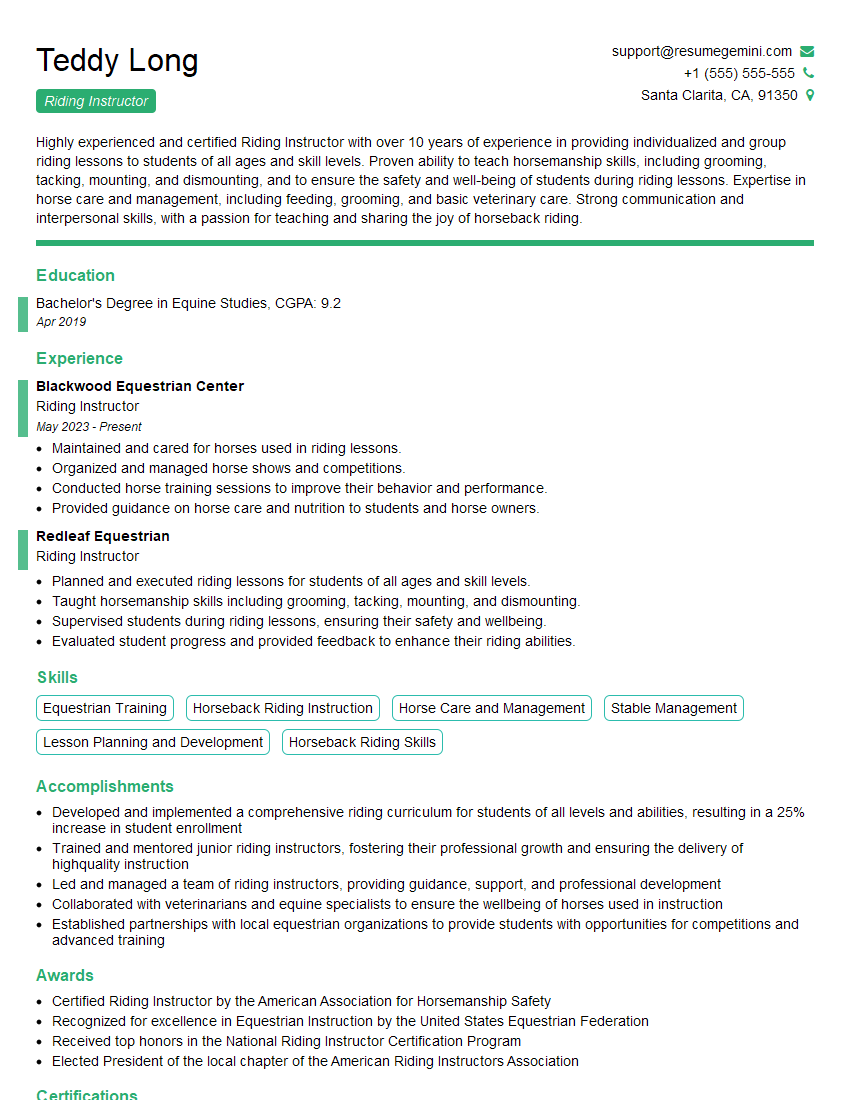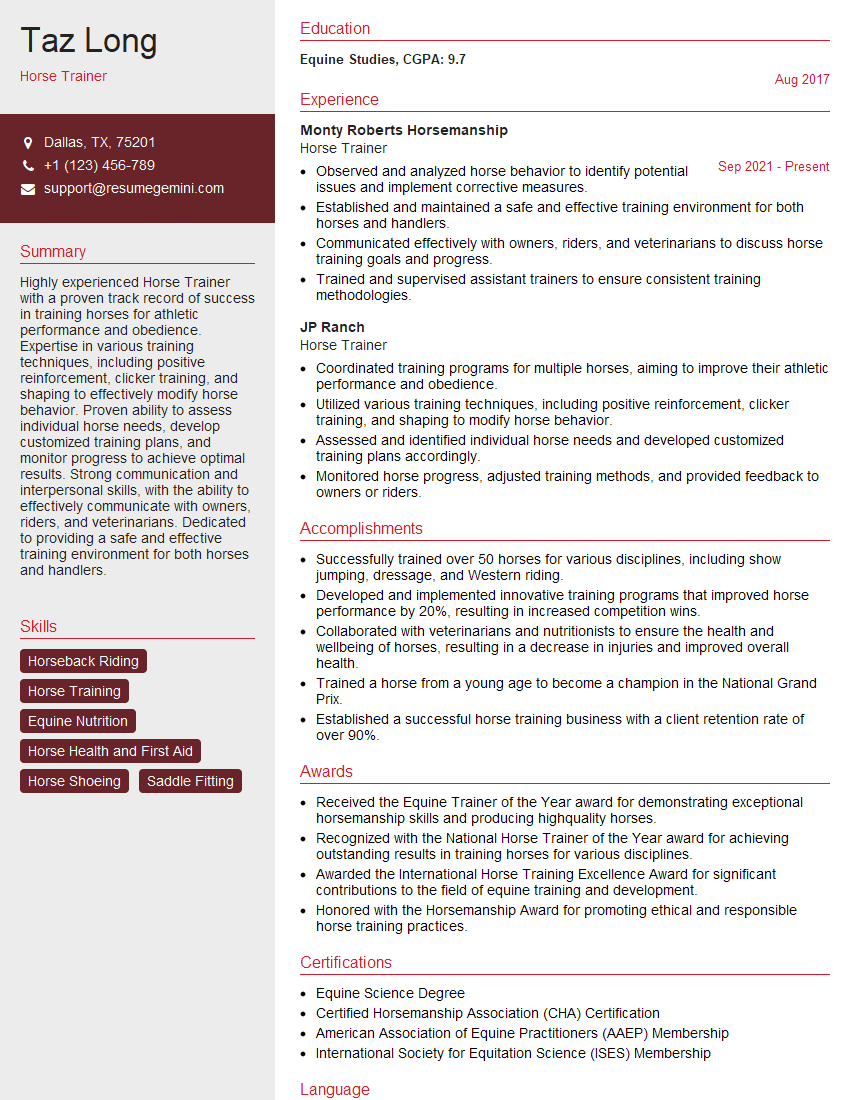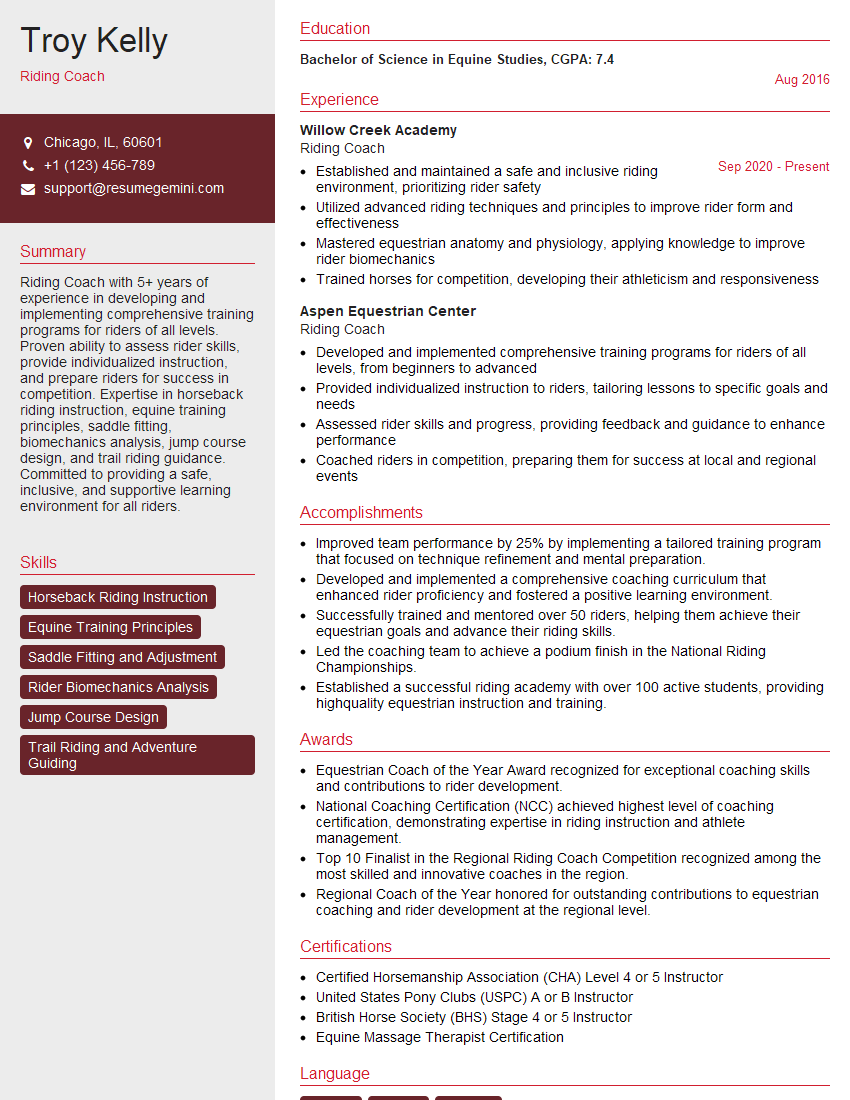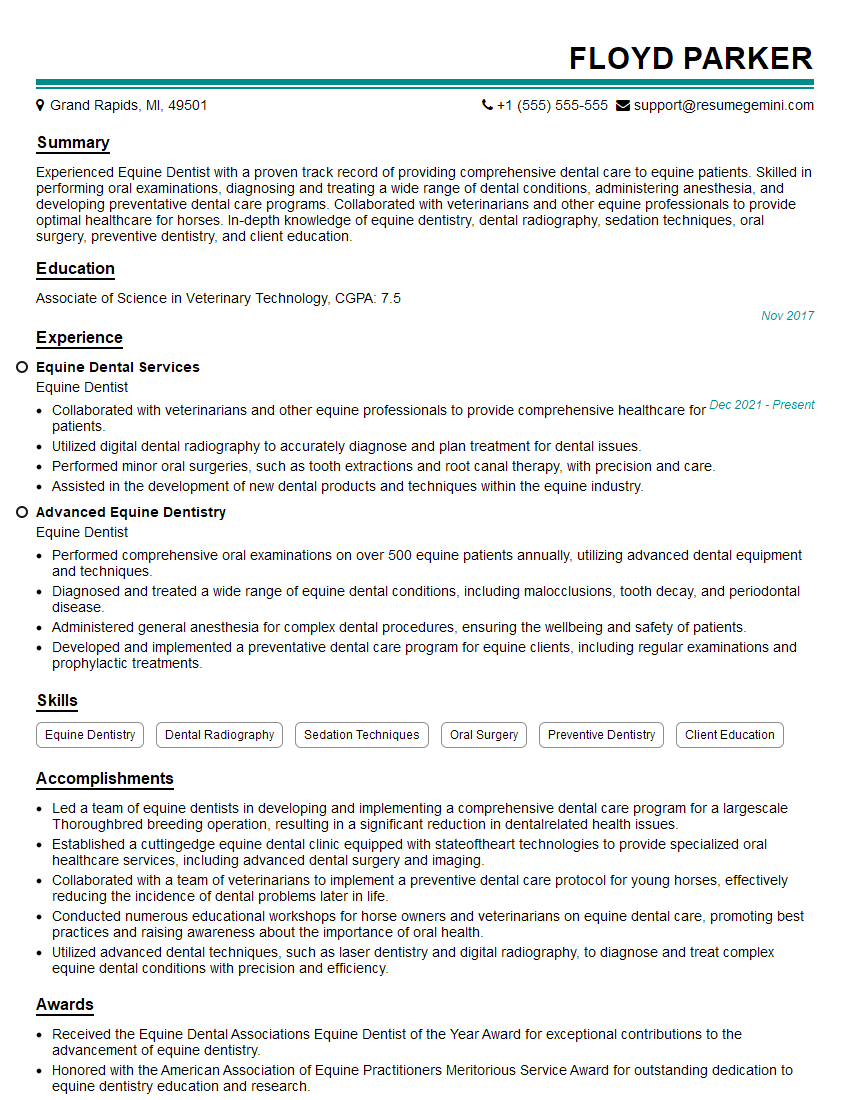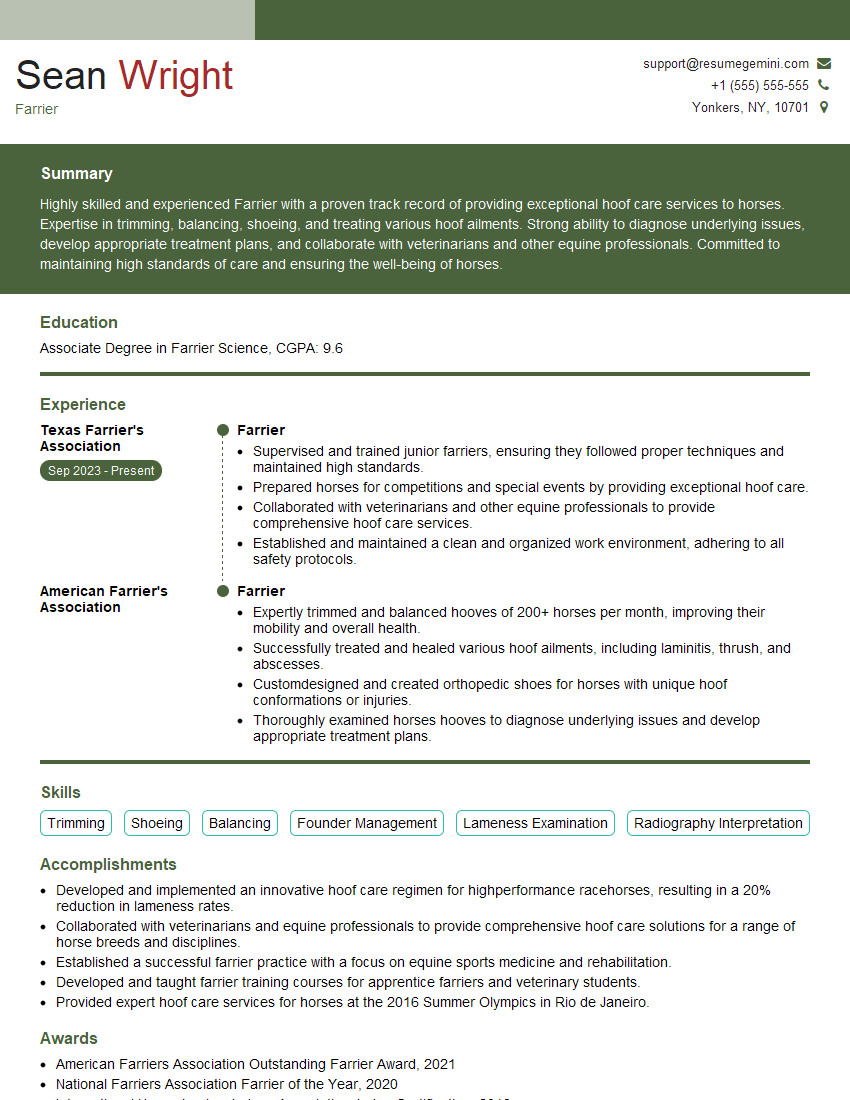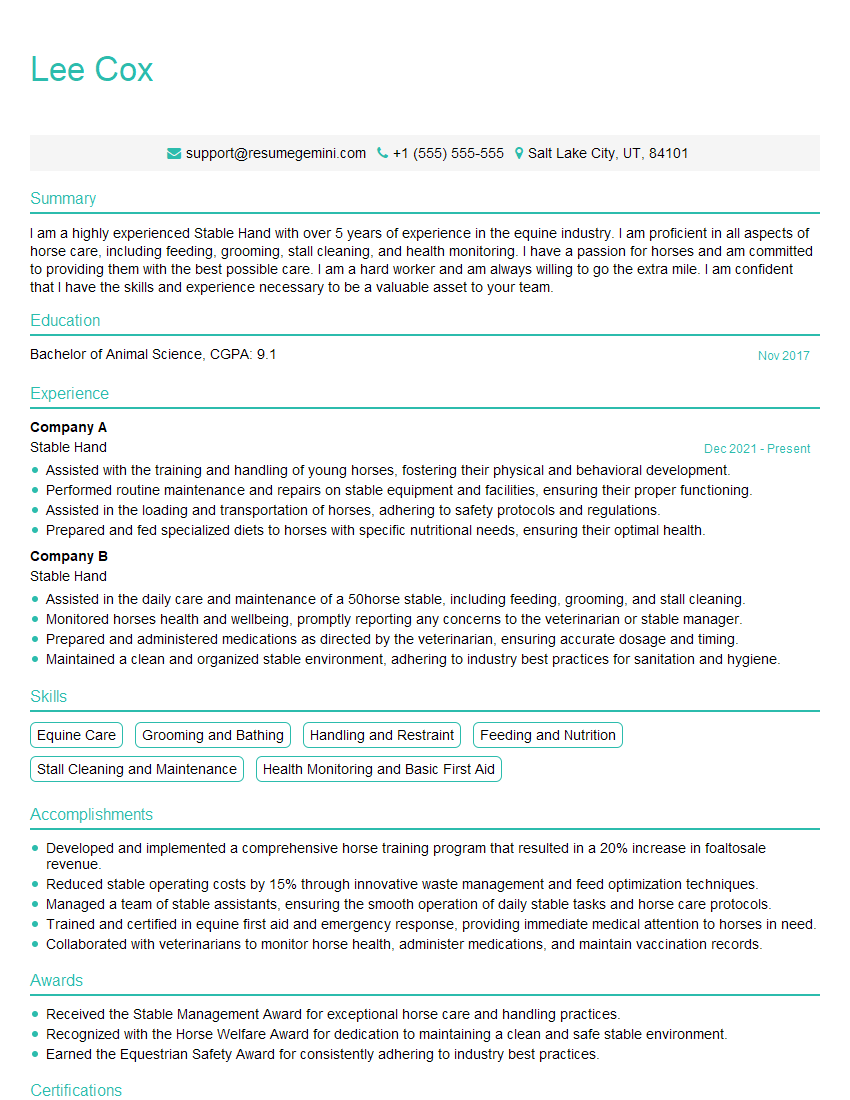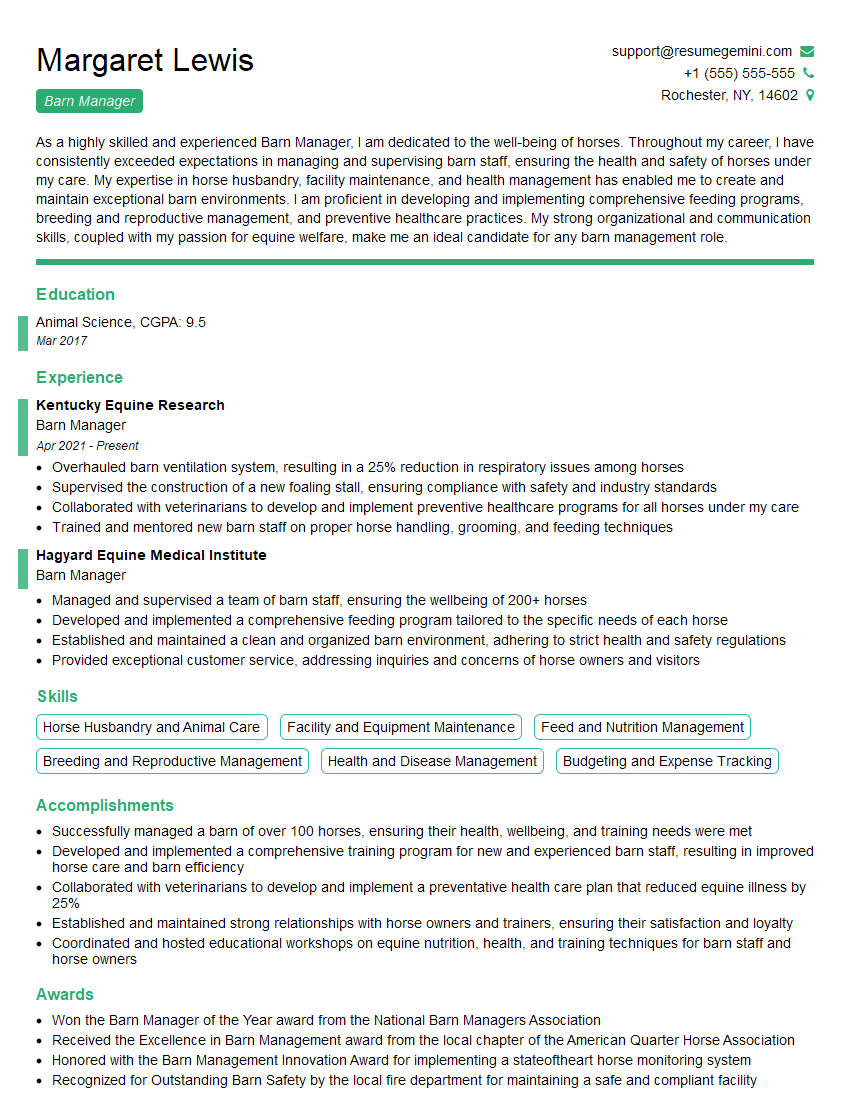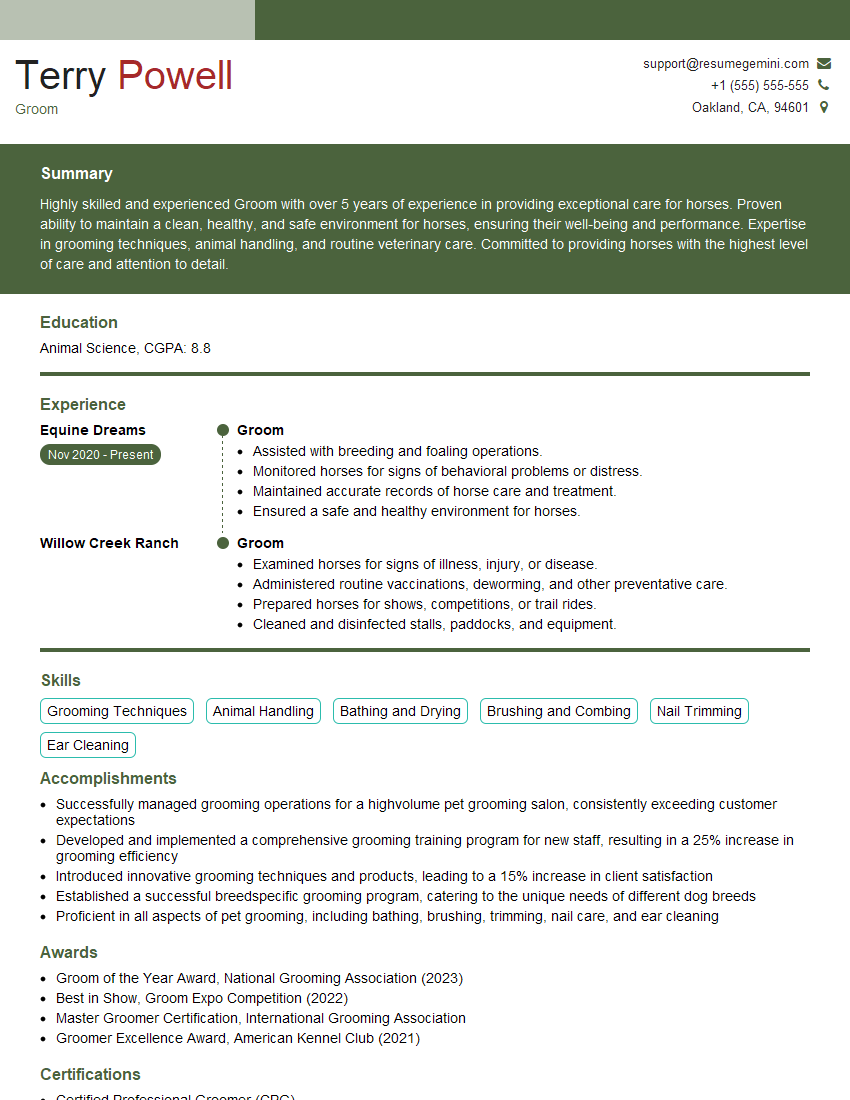Are you ready to stand out in your next interview? Understanding and preparing for Commitment to the safety and well-being of the horses and participants interview questions is a game-changer. In this blog, we’ve compiled key questions and expert advice to help you showcase your skills with confidence and precision. Let’s get started on your journey to acing the interview.
Questions Asked in Commitment to the safety and well-being of the horses and participants Interview
Q 1. Describe your experience implementing equine safety protocols.
Implementing equine safety protocols is paramount to my work. My approach is multifaceted, beginning with a thorough risk assessment of all areas where horses and humans interact. This includes the riding arena, stables, paddocks, and even pathways. I’ve developed and implemented comprehensive safety plans encompassing everything from stable management (ensuring secure stalls, proper ventilation, and the safe handling of feed and medications) to riding protocols (strict adherence to helmet rules, appropriate riding attire, and clear communication amongst riders and instructors).
For example, I’ve established a detailed system for checking tack before every ride, ensuring girths are properly secured, bridles fit correctly, and all equipment is in good working order. I’ve also instituted regular safety training for all staff and volunteers, covering topics such as safe horse handling techniques, emergency procedures, and recognizing signs of stress or illness in horses. Beyond this, I’ve worked to create a culture of safety, where everyone feels empowered to report potential hazards and where safety is valued above all else.
Q 2. What are the three most important aspects of horse safety?
The three most crucial aspects of horse safety are:
- Proper Handling Techniques: This involves understanding equine body language, knowing how to approach and lead a horse safely, and employing appropriate restraint techniques when necessary. For instance, always approaching a horse from its side rather than directly in front helps avoid startling it.
- Environmental Safety: Creating and maintaining a safe environment is vital. This includes secure fencing, well-maintained facilities, and removing potential hazards such as loose objects in the arena or slippery surfaces. I meticulously check the riding areas daily, looking for loose nails, broken equipment, or potential trip hazards.
- Rider Skill and Matching: Matching riders to appropriate horses based on skill level is crucial. I carefully evaluate riders’ capabilities and assess which horse will provide a safe and suitable experience. Pushing a rider beyond their ability can lead to accidents. For example, I would never put a beginner rider on a highly spirited horse.
Q 3. How would you handle a horse spooking during a lesson?
If a horse spooks during a lesson, my immediate response prioritizes the safety of both the horse and the rider. The first step is to remain calm and avoid any sudden movements that could further frighten the horse. I would gently use my voice to reassure the horse, and if necessary, I’d guide the horse away from the source of the spook. I might instruct the rider to loosen the reins and remain quiet, preventing any sudden tugging on the bit which could exacerbate the situation.
My training emphasizes the use of soft, confident handling rather than harsh corrections which could further distress the horse. After assessing the situation and ensuring both rider and horse are safe, I would work on desensitizing the horse to whatever caused the spook, using positive reinforcement techniques. If necessary, I’d adjust the lesson to avoid a recurrence of the triggering event.
Q 4. Explain your process for assessing a horse’s suitability for a rider.
Assessing a horse’s suitability for a rider is a multi-stage process. It begins with observing the horse’s temperament and behavior in various situations: how it interacts with other horses, how it responds to handling, and its overall energy level. Then, I consider the rider’s experience, riding style, and physical capabilities. A calm, well-behaved horse might be ideal for a beginner, while an experienced rider could comfortably handle a more spirited horse.
I document the horse’s history, noting any behavioral issues, injuries, or previous riding experiences. This information aids in pairing riders with horses that match their skills and experience level, ensuring a safe and positive learning experience. Any health concerns would be taken into account as well. For example, a horse with a history of lameness would not be suited for strenuous riding activities.
Q 5. What are the signs of colic in a horse, and what’s your immediate response?
Colic, a severe abdominal pain in horses, manifests in various ways. Signs can include pawing at the ground, rolling, kicking at the abdomen, restlessness, and changes in appetite or behavior. Some horses might exhibit subtle signs like decreased manure production. The severity can range from mild discomfort to life-threatening situations.
My immediate response to suspected colic involves contacting the veterinarian immediately. In the interim, I would keep the horse calm and comfortable, avoiding feeding or watering to minimize risk. The horse should be observed carefully, noting the severity and frequency of the symptoms. The veterinarian’s advice will dictate subsequent actions, which might range from medication administration to emergency surgery. Early detection and prompt veterinary attention are crucial for a positive outcome.
Q 6. Describe your knowledge of equine first aid.
My equine first aid knowledge encompasses a wide range of skills. This includes wound care (cleaning, bandaging, and recognizing infections), managing minor injuries such as cuts and abrasions, and recognizing the signs of more serious conditions that require immediate veterinary intervention. I am trained in how to handle and prevent shock, provide basic respiratory support, and immobilize injuries.
I am proficient in the use of common equine first aid supplies like antiseptic solutions, bandages, and splints. I regularly update my knowledge and skills through continuing education courses to ensure I’m up to date on the latest best practices. Furthermore, I maintain a well-stocked first aid kit readily accessible in case of emergencies. This includes a comprehensive list of emergency contacts, including the local veterinarian and emergency services.
Q 7. How do you ensure the safety of riders with varying skill levels?
Ensuring the safety of riders with varying skill levels requires a tailored approach. Beginner riders are matched with calm, well-trained horses and receive close supervision from instructors. Lessons are carefully structured to gradually build skills and confidence. For example, beginners start with basic exercises like walking and trotting before moving to more challenging activities.
More experienced riders can work with more spirited horses and undertake more advanced riding techniques under appropriate supervision. Regular assessment of the rider’s progress ensures that the horse and lesson plan remain appropriate. Furthermore, communication is key; riders are encouraged to voice any concerns or anxieties. Throughout all lessons, clear instructions, regular safety checks, and a focus on rider confidence contribute to a safe and enjoyable riding experience for everyone.
Q 8. How would you manage a situation where a rider falls from a horse?
Responding to a rider fall requires a calm, swift, and systematic approach. First priority is ensuring the rider’s safety. We assess their injuries – are they conscious? Are there any obvious fractures or bleeding? Then we attend to the horse; is it spooked? Do we need to restrain it gently to prevent further injury? We immediately call for emergency medical services (EMS) if necessary, describing the situation clearly (location, rider’s condition, and horse’s behavior). If the fall is minor and the rider is unharmed, we ensure the horse is calm and lead it away from the immediate area. A thorough incident report is completed afterward to identify contributing factors and prevent future occurrences. For instance, if a stirrup broke, that piece of equipment needs immediate attention. If the horse stumbled, the riding surface might need review. This systematic approach, from immediate first aid to thorough reporting, is critical for both rider and horse well-being.
Example: During a lesson, a young rider fell and suffered a minor concussion. We followed our protocol: assessed the rider, called EMS who performed a thorough evaluation on-site, kept the horse calm and separated from the other horses. Post-incident, we reviewed the saddle fit and checked the rider’s riding posture to prevent reoccurrence.
Q 9. Outline your emergency procedures for handling horse injuries.
Our emergency procedures for horse injuries are designed to minimize suffering and promote rapid recovery. We immediately isolate the injured horse to prevent further harm or spreading of any potential infection. We contact our veterinarian immediately and clearly describe the injury (location, severity, symptoms). Depending on the injury, we may administer first aid such as cleaning and bandaging wounds, applying cold compresses for swelling, or supporting injured limbs. We document everything meticulously: the time of the incident, the nature of the injury, first aid provided, and the vet’s recommendations. If the horse is severely injured, appropriate transportation arrangements will be made. Regularly scheduled vet check-ups help prevent many issues and aid in early detection.
Example: A horse suffered a deep laceration to its leg. We immediately cleaned and bandaged the wound, called the vet, and administered pain relief as directed. We kept the horse in a clean, quiet stall to avoid stress while the vet examined and sutured the wound.
Q 10. What are your strategies for preventing accidents in the stable?
Accident prevention in the stable is paramount. Our strategy involves a multi-pronged approach: regular safety inspections, proper equipment maintenance, and stringent adherence to safety protocols. We ensure all stalls are properly secured to prevent horses from escaping, and that all tools are stored safely and out of reach of the horses. We eliminate hazards such as loose objects, uneven flooring, or protruding nails. We regularly maintain and inspect our equipment (saddles, bridles, fences) and replace worn-out items promptly. We conduct regular training for our staff on safe handling procedures and emergency response. Education is key for maintaining safety, and clear signage is utilized to remind everyone of stable safety rules. For example, we use color-coded signs to signify areas requiring extra caution.
Example: Weekly checks of stall latches, regular hoof inspections, and monthly maintenance checks on our fencing system.
Q 11. Describe your understanding of equine behavior and how it impacts safety.
Understanding equine behavior is essential for safety. Horses communicate through body language; subtle shifts in posture, ear position, tail movement, and eye contact can signal nervousness, aggression, or fear. Recognizing these cues allows us to anticipate potential problems and adjust our approach accordingly. For example, a horse swishing its tail vigorously and pinning its ears back might indicate it’s feeling threatened and needs space. Respecting a horse’s personal space, utilizing calm and consistent handling techniques, and avoiding sudden movements all contribute to a safer environment. Moreover, understanding herd dynamics is vital – a dominant horse might react negatively to intrusion, creating safety concerns.
Example: A horse displaying signs of stress before mounting can be identified early, and steps can be taken to calm it, like gentle grooming, before proceeding to the ride.
Q 12. How do you assess and mitigate risks associated with trail riding?
Trail riding carries inherent risks. Our risk assessment involves evaluating the trail’s condition (terrain, obstacles, width), considering weather conditions (extreme heat, rain, storms), and the riders’ experience level. We always match the horses to the riders’ abilities. We plan a safe route, avoiding hazardous areas and ensuring the trail is suitable for the horses’ fitness. Before each ride, horses are checked for soundness, equipment is inspected, and riders receive a thorough briefing on trail safety, including emergency contact procedures. We always ride in groups, with designated leaders and sweep riders to ensure no one gets left behind and to provide support. A first-aid kit and emergency contact information are carried at all times.
Example: Before a trail ride, we inspect the trail for any loose rocks or fallen branches, evaluate the weather forecast, and confirm each rider is comfortable and their horses are suitable for the chosen path.
Q 13. Explain your approach to maintaining a safe and clean stable environment.
Maintaining a safe and clean stable environment is crucial for the health and well-being of the horses and staff. This involves regular cleaning of stalls, aisles, and tack rooms; removing manure and waste daily, and disinfecting areas to prevent disease outbreaks. We regularly check for structural issues within the stables and ensure proper ventilation to avoid buildup of ammonia. Regular fly control measures and parasite control are also important. Appropriate storage of feed and bedding materials prevents spoilage and infestations. A strict protocol is established and enforced to ensure proper hygiene standards.
Example: Daily stall cleaning, weekly disinfecting of water troughs, and monthly deep cleaning of the stable.
Q 14. How do you communicate safety guidelines effectively to riders and staff?
Effective communication is central to safety. We use multiple channels – written guidelines (posters in the stable), safety briefings before each ride or lesson, and regular training sessions for staff to convey safety procedures. We involve riders in discussions about safety measures, answering their questions, and addressing their concerns. We use clear and concise language, avoiding jargon, and supplement verbal communication with visual aids (diagrams, videos). We regularly review and update our safety guidelines to reflect best practices and lessons learned from incidents (if any).
Example: We hold a monthly safety meeting where staff discusses safety issues and brainstorm potential solutions. We use visual aids to explain proper mounting and dismounting techniques to minimize the chance of injury during training sessions.
Q 15. What is your experience with equipment safety checks (saddles, bridles, etc.)?
Equipment safety checks are paramount to ensuring both rider and horse safety. My experience encompasses a rigorous, multi-step process. Before every ride, I personally inspect saddles for cracks, loose stitching, and proper girth placement. I check bridles for broken or frayed reins, correctly fitted bits, and secure buckles. I also examine stirrup leathers for wear and tear and ensure the overall integrity of the tack. Think of it like a pre-flight check for an airplane – meticulous and thorough. I also involve the riders in this process, educating them to identify potential problems. For example, I’ll show them how to visually inspect a girth for wear and demonstrate proper adjustment.
- Visual Inspection: A thorough visual check for any signs of damage or wear.
- Functionality Check: Testing the movement of buckles, straps, and stirrups.
- Fit Assessment: Ensuring the saddle and bridle fit the horse correctly.
Regular maintenance is key; saddles and bridles should be professionally cleaned and serviced at least annually to prevent degradation.
Career Expert Tips:
- Ace those interviews! Prepare effectively by reviewing the Top 50 Most Common Interview Questions on ResumeGemini.
- Navigate your job search with confidence! Explore a wide range of Career Tips on ResumeGemini. Learn about common challenges and recommendations to overcome them.
- Craft the perfect resume! Master the Art of Resume Writing with ResumeGemini’s guide. Showcase your unique qualifications and achievements effectively.
- Don’t miss out on holiday savings! Build your dream resume with ResumeGemini’s ATS optimized templates.
Q 16. How would you deal with a conflict between riders?
Conflicts between riders are addressed promptly and fairly. My approach prioritizes de-escalation and finding a mutually agreeable solution. First, I listen to each rider’s perspective, creating a safe space where they feel heard. I focus on understanding the root cause of the conflict, whether it’s a misunderstanding, a difference in riding styles, or a competitive issue. If the conflict involves safety concerns, I will take immediate action, potentially separating the riders.
For example, if a conflict arises due to differing riding paces during a group trail ride, I will explain that safety requires maintaining a consistent pace or create smaller, more homogeneous groups. For more significant disputes, I’ll facilitate a structured discussion, emphasizing compromise and respect. Ultimately, I want to promote a positive and supportive environment where riders learn and grow together. This may involve setting clear expectations regarding group riding etiquette or reminding everyone that the focus should be on enjoyment and safety, not competition.
Q 17. How do you ensure the well-being of horses during hot weather?
Horse welfare in hot weather is critical. Our approach employs a multi-pronged strategy. We monitor the temperature closely and adjust riding schedules accordingly, avoiding the hottest parts of the day. Horses are given ample access to water, both in troughs and through frequent hydration breaks during rides. We also increase the frequency of cooling measures, like sponging down their bodies with cool water and allowing for adequate rest in shaded areas. We are very mindful of the signs of heat stress such as excessive sweating, rapid breathing, and lethargy. Any horse displaying these symptoms is immediately removed from activity and provided with extra care and cooling measures.
This might involve using cooling blankets, misting fans, or even seeking veterinary advice if the situation worsens. Just as humans need to take precautions in extreme heat, we ensure the horses’ needs are prioritized. We consider the overall workload of the horses during this time, and try to avoid working them too hard when it’s hot.
Q 18. Describe your knowledge of equine diseases and preventative measures.
My understanding of equine diseases and preventative measures is extensive. I’m proficient in identifying symptoms of common illnesses such as colic, laminitis, and strangles. Preventative measures form the cornerstone of our health program. This includes regular parasite control through deworming, vaccination against common diseases like influenza and tetanus, and maintaining a clean and hygienic stable environment. We also conduct regular hoof care and employ a stringent biosecurity protocol to minimise the risk of contagious diseases. This means limiting contact between our horses and external animals and having strict cleaning procedures for tack and vehicles.
Beyond the preventative measures, we are constantly monitoring for any signs of illness or injury. Regular veterinary check-ups are essential and early detection of any problem helps us minimise the impact of the illness.
Q 19. What are the signs of a horse in distress?
Recognizing signs of distress in a horse is crucial. They often exhibit subtle cues that may be overlooked by the untrained eye. Obvious signs include laboured breathing, excessive sweating, reluctance to move, or unusual behaviour such as pawing or rolling excessively. Subtle signs might involve changes in appetite, a dull coat, or unusual sounds during respiration. A change in posture, such as drooping ears or a lowered head, can also be indicative of distress. A particularly important sign is a change in their behavior – if a horse you know well suddenly acts differently, this deserves further attention.
If I notice any such signs, I immediately assess the situation and determine if veterinary attention is needed.
Q 20. How do you train staff to adhere to safety protocols?
Training staff on safety protocols involves a structured program that combines theoretical learning and practical application. Initial training covers emergency procedures, animal handling techniques, and the importance of regular equipment checks. We use a combination of classroom sessions, demonstrations, and hands-on practice to ensure that knowledge is correctly implemented. We regularly review safety procedures and implement refresher courses to ensure staff proficiency. Clear, concise safety guidelines are distributed in writing and displayed prominently in the stable area.
Regular drills and simulations help the staff to react in a real-life scenario such as a horse falling or a rider getting injured. These drills help make safety procedures second-nature.
Q 21. How do you handle aggressive or unpredictable horses?
Handling aggressive or unpredictable horses requires a calm, confident, and experienced approach. We prioritize the safety of both staff and the horse. Our procedures dictate the use of appropriate equipment such as protective gear (gloves, chaps) and specialized handling tools. The behaviour is observed to help us understand the root cause (e.g., pain, fear, or hormonal changes). If necessary we consult with a veterinarian or equine behaviour specialist to create a management plan tailored to the specific needs of the animal.
For example, a horse prone to biting might need to be handled with a long lead rope and muzzle. If the horse is aggressive and a immediate threat, you may need to keep others at a safe distance. This process prioritizes both the safety and well-being of the horse and others.
Q 22. What is your experience with liability and insurance related to equestrian activities?
Liability and insurance in equestrian activities are crucial. My experience encompasses understanding various types of coverage, including general liability, equine liability, and professional liability. This includes knowing the differences between policies and ensuring adequate coverage for accidents involving horses, riders, and spectators. For example, a comprehensive policy should cover medical expenses from rider falls, damage to property, and legal fees from potential lawsuits. I’ve personally worked with multiple insurers to tailor policies to the specific needs and risks of various equestrian operations, considering factors like the number of horses, types of activities offered (lessons, trail rides, competitions), and the experience level of riders. Understanding policy exclusions is equally vital, as this helps prevent unforeseen gaps in coverage. It’s not just about having insurance; it’s about understanding its intricacies and proactively mitigating risks to minimize incidents requiring claims.
Q 23. How do you ensure the safety of children participating in riding lessons?
Ensuring child safety in riding lessons is paramount. My approach is multi-faceted, beginning with a thorough risk assessment of the riding area and equipment. This involves regularly checking the arena for hazards, ensuring tack (saddles, bridles) is in good repair, and the horses are properly fitted with equipment. Lessons are always supervised by qualified instructors with appropriate ratios of instructors to children, depending on the children’s experience and age. I emphasize clear and age-appropriate safety instruction, including rules about mounting and dismounting, appropriate horse behavior, and emergency procedures. Children are provided with helmets that meet safety standards, and proper riding attire is encouraged. I use positive reinforcement techniques to encourage safe practices. For example, a ‘buddy system’ for younger riders ensures constant supervision. Finally, I maintain detailed accident reports for continuous improvement of safety protocols, learning from past experiences to prevent future occurrences.
Q 24. Explain your knowledge of proper horse handling techniques.
Proper horse handling is fundamental. My knowledge includes understanding horse behavior, body language, and safe handling procedures. This includes approaching a horse calmly, speaking softly, and avoiding sudden movements. I teach techniques for leading, grooming, and saddling, emphasizing the importance of controlling the horse’s head and maintaining a safe distance. I know how to assess a horse’s temperament and adjust my approach accordingly. For instance, a nervous horse might require a more gentle and patient approach, whereas a more confident horse may need firmer handling. Understanding the horse’s flight zone (the area around the horse that triggers its escape response) is crucial for avoiding accidents. I always use appropriate equipment, like lead ropes and halters, to control the horse safely. I also emphasize the importance of proper riding posture and aids to maintain control and balance during riding activities.
Q 25. What are your methods for preventing and responding to horse bites or kicks?
Preventing horse bites and kicks requires a proactive approach based on understanding equine behavior and taking appropriate precautions. This begins with regular training and handling to desensitize horses to human contact and teach them to be respectful of boundaries. Maintaining a safe distance from the horse’s hindquarters and head is crucial. Never approach a horse from behind or without it seeing you. It’s also vital to avoid startling or frightening the horse. When handling a horse, I make sure to be aware of its body language, including its ears, tail, and overall demeanor. In the event of a bite or kick, I prioritize immediate first aid and contact appropriate veterinary and medical personnel. Detailed records of the incident, including the horse’s history and any contributing factors, are maintained to aid investigation and prevent similar occurrences.
Q 26. How do you monitor the health and well-being of the horses under your care?
Monitoring horse health and well-being is a daily commitment. It involves regular observation of each horse’s behavior, appetite, coat condition, and manure. I collaborate closely with a veterinarian for routine vaccinations, deworming, and dental care. Horses’ hooves are regularly inspected and trimmed by a farrier. I maintain detailed health records for each horse, noting any changes in behavior or health and consulting the vet promptly if needed. For example, a sudden change in appetite or a limp could be indicators of a problem requiring immediate attention. I prioritize providing appropriate nutrition, stable care, and regular exercise tailored to the horse’s individual needs and age. This ensures the horses are healthy and comfortable, contributing to both their well-being and safety during riding activities.
Q 27. Describe your experience in creating and enforcing safety policies.
Creating and enforcing safety policies is a continuous process. I develop comprehensive policies covering all aspects of equestrian operations, from horse handling and riding procedures to emergency response plans. These policies are communicated clearly to all staff and participants through training sessions and written materials. I ensure the policies comply with all relevant regulations and best practices. Regular safety audits and inspections are performed to identify potential hazards and ensure that policies are being followed consistently. For instance, we have a detailed protocol for handling emergencies, such as falls or injuries, and regular fire drills to prepare everyone for unexpected events. This proactive approach ensures a safe environment for everyone involved, and provides a framework for continuous improvement of safety measures.
Key Topics to Learn for Commitment to the Safety and Well-being of Horses and Participants Interview
- Horse Behavior and Handling: Understanding equine body language, safe handling techniques, recognizing signs of stress or illness in horses, and implementing appropriate responses.
- Risk Assessment and Mitigation: Identifying potential hazards in various equestrian settings (e.g., riding arenas, trails, stables), developing and implementing safety protocols, and conducting regular safety checks.
- Emergency Procedures: Knowledge of first aid for both horses and humans, familiarity with emergency contact protocols, and experience in handling emergency situations (e.g., accidents, injuries).
- Participant Safety Education and Supervision: Developing and delivering safety briefings to participants, enforcing safety rules, and effectively supervising activities to minimize risks.
- Facility Safety and Maintenance: Understanding and adhering to safety regulations for facilities, ensuring proper maintenance of equipment, and identifying and addressing potential hazards in the environment.
- Ethical Considerations: Prioritizing the well-being of horses above all else, understanding ethical guidelines for animal care and handling, and demonstrating a commitment to responsible equestrian practices.
- Communication and Teamwork: Effectively communicating safety concerns and procedures to colleagues and participants, working collaboratively to maintain a safe environment, and addressing safety concerns promptly and professionally.
- Regulatory Compliance: Familiarity with relevant safety regulations and guidelines related to equestrian activities and animal welfare.
Next Steps
Mastering the commitment to the safety and well-being of horses and participants is crucial for career advancement in the equestrian industry. It demonstrates your responsibility, professionalism, and dedication to the animals and people under your care. This is highly valued by employers and will significantly enhance your job prospects. Building an ATS-friendly resume is key to getting your application noticed. We strongly encourage you to use ResumeGemini to craft a compelling and effective resume that showcases your skills and experience in this area. ResumeGemini offers a user-friendly platform and provides examples of resumes tailored to highlight a commitment to safety and well-being, helping you stand out from the competition.
Explore more articles
Users Rating of Our Blogs
Share Your Experience
We value your feedback! Please rate our content and share your thoughts (optional).
What Readers Say About Our Blog
Hi, I represent an SEO company that specialises in getting you AI citations and higher rankings on Google. I’d like to offer you a 100% free SEO audit for your website. Would you be interested?
good

